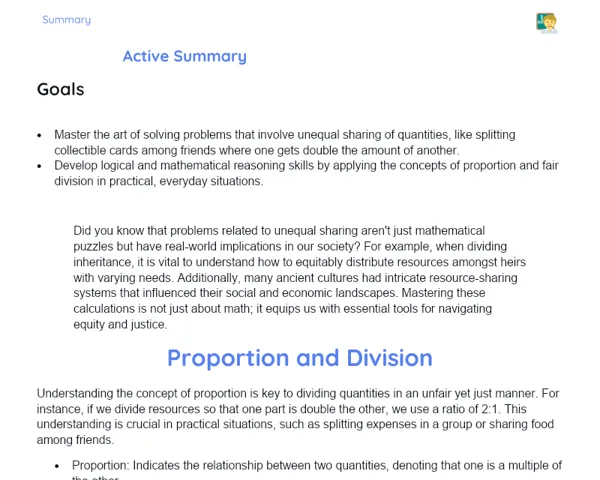Objectives
1. 🎯 To grasp and effectively use Cavalieri's Principle to compare and determine the volumes of various geometric solids.
2. 🔍 To develop logical reasoning and critical thinking skills when assessing whether different objects possess the same volume or distinct volumes.
3. 🤝 To foster collaboration and discussion among students while tackling practical problems associated with Cavalieri's Principle.
4. 🖥️ To encourage the incorporation of digital tools for visualizing and manipulating three-dimensional geometric figures.
Contextualization
Did you know that Cavalieri's Principle extends far beyond mathematics? It's a vital tool in fields like architecture and product design. This groundbreaking principle enables professionals to compare volumes of objects with intricate shapes without having to measure every little detail. By mastering Cavalieri's Principle, you not only sharpen your mathematical abilities but also gain a deeper understanding of the world around you and its real-world applications.
Important Topics
Cavalieri's Principle
Cavalieri's Principle, introduced by Bonaventura Cavalieri in the 17th century, is a key concept in spatial geometry that enables the comparison of volumes of solids that may have different shapes but share the same height. It states that if two solid regions have cross-sections with equal areas for every line drawn parallel to a fixed direction, then both regions have identical volumes.
-
This principle underlines the idea that when it comes to volume, the shape of the solid isn't the primary factor; instead, it's the area of the parallel cross-sections with the same base that matters.
-
Utilizing this principle allows for the evaluation and comparison of complex object volumes without needing to measure every detail, which is incredibly beneficial in practical domains such as architecture and engineering.
-
Grasping Cavalieri's Principle also enhances visualization and modeling of mathematical and physical challenges, providing a potent tool for addressing issues tied to the volumes of irregular solids.
Volume Comparison
To compare volumes using Cavalieri's Principle, it's about determining if two distinct solids—with equal cross-sectional areas—have the same volume. This requires understanding how the shapes of objects can affect their cross-sectional areas, and thus their total volumes.
-
Volume comparison is crucial for resolving practical challenges related to spatial efficiency, particularly in packaging design and urban planning.
-
This approach nurtures critical thinking and logical reasoning skills, since students must apply the principle across various contexts and appreciate the differences in shapes.
-
The capacity to assess the volumes of solids is also foundational in the study of integral calculus, where Cavalieri's Principle serves as a significant basis for comprehending definite integrals.
Solid Modeling
Solid modeling involves crafting three-dimensional representations of physical or abstract objects. This is especially pertinent during geometry studies and practical applications in design and engineering. Cavalieri's Principle can aid in modeling to confirm volume equivalence, allowing students to delve into and better understand three-dimensional shapes.
-
Modeling solids assists students in visualizing intricate mathematical concepts more tangibly, facilitating the understanding and application of Cavalieri's Principle.
-
This activity fosters creativity and critical thinking as students experiment with various shapes to derive solutions for complex geometric problems.
-
Solid modeling is also excellent preparation for future studies in engineering and design, where visualization and comprehension of volumes are essential for achieving success.
Key Terms
-
Cavalieri's Principle: A geometric principle stating that when two solid regions have equal cross-sectional areas for all sections parallel to a fixed direction, they will have the same volume.
-
Volume: The measure of three-dimensional space occupied by an object. In the context of Cavalieri's Principle, volume is what is compared among different solids to determine whether their volumes are equal.
-
Cross-Section: A section of an object made by a plane that is perpendicular to the main axis. This is vital for applying Cavalieri's Principle to ascertain volume equivalence.
For Reflection
-
How can we apply Cavalieri's Principle to tackle practical design and engineering challenges, particularly when dealing with complex and irregular shapes?
-
In what ways can an understanding of Cavalieri's Principle contribute to grasping advanced calculus concepts, like definite integrals?
-
What are the limitations of Cavalieri's Principle, and in what circumstances may it not be appropriate for volume comparison?
Important Conclusions
-
We've revisited Cavalieri's Principle and highlighted its significance in comparing volumes of solids with varying shapes but equal cross-sectional areas, which is critical in practical fields such as architecture and engineering.
-
We've discussed how this principle not only assists in volume analysis but also cultivates logical reasoning and modeling capabilities, essential in mathematics as well as various other professional arenas.
-
We explored practical examples that showcase the relevance of Cavalieri's Principle, preparing you to apply this knowledge in real-world, complex scenarios while also recognizing its limitations.
To Exercise Knowledge
- Using materials like modeling clay, create two solids with distinct bases but identical volumes. Ensure volume equality by applying Cavalieri's Principle. 2. Sketch two intricate geometric shapes in a 3D modeling software and verify if they possess the same volume by utilizing Cavalieri's Principle. 3. Draft a brief report detailing how you would employ Cavalieri's Principle to maximize space in an architectural project of your choice.
Challenge
🚀 Space Designer Challenge: Picture yourself as a space designer aboard a space station. You need to conceptualize storage modules that optimize volume efficiency. Leverage Cavalieri's Principle to design two modules with different shapes that maintain equivalent internal volumes. Present your design in an explanatory video!
Study Tips
-
Utilize visual aids such as videos and online simulations to observe Cavalieri's Principle in practice, which will help solidify your understanding.
-
Attempt to teach Cavalieri's Principle to a peer or a family member. Teaching is a fantastic way to reinforce concepts.
-
Work through geometry problems that incorporate Cavalieri's Principle. The more you practice, the more confident you'll become in applying this principle across various contexts.



